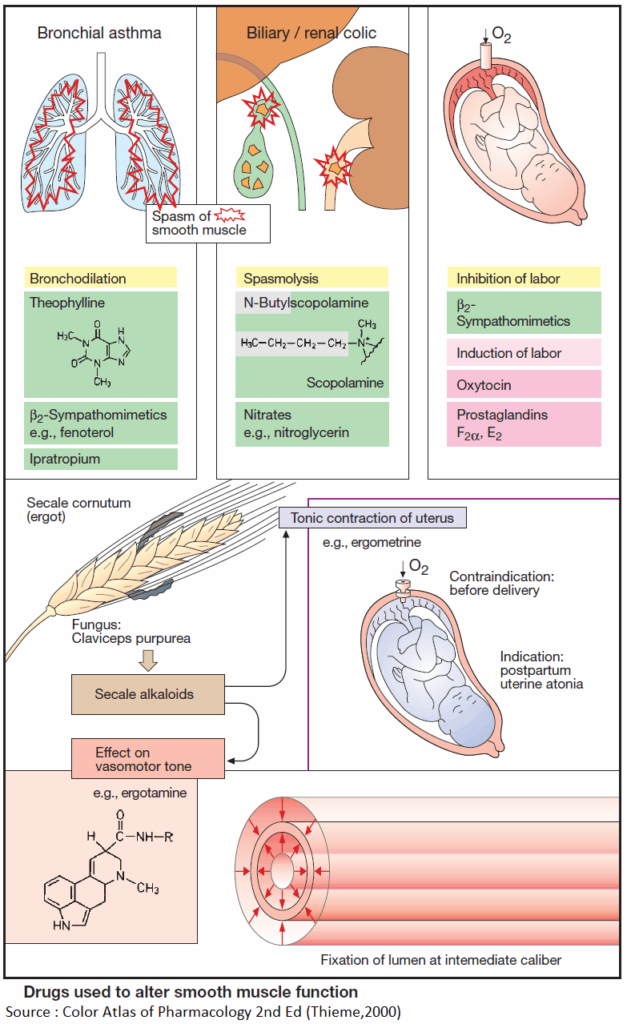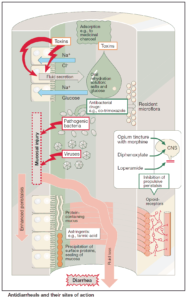Table of Contents
Bronchodilators
Narrowing of bronchioles raises airway resistance, e.g., in bronchial or bronchitic asthma. Several substances that are employed as bronchodilators are:
- β2-sympathomimetics (given by pulmonary, parenteral, or oral route)
- methylxanthine theophylline (given parenterally or orally)
- parasympatholytic ipratropium (given by inhalation)
Spasmolytics
N-Butylscopolamine is used for the relief of painful spasms of the biliary or ureteral ducts. Its poor absorption (N.B. quaternary N; absorption rate <10%) necessitates parenteral administration.
Because the therapeutic effect is usually weak, a potent analgesic is given concurrently, e.g., the opioid meperidine. Note that some spasms of intestinal musculature can be effectively relieved by organic nitrates (in biliary colic) or by nifedipine (esophageal hypertension and achalasia).
Myometrial relaxants (Tocolytics)
β2-Sympathomimetics such as fenoterol or ritodrine, given orally or parenterally, can prevent premature labor or interrupt labor in progress when dangerous complications necessitate cesarean section. Tachycardia is a side effect produced reflexly because of β2-mediated vasodilation or direct stimulation of cardiac β1-receptors.
Magnesium sulfate, given i.v., is a useful alternative when β-mimetics are contraindicated, but must be carefully titrated because its nonspecific calcium antagonism leads to blockade of cardiac impulse conduction and of neuromuscular transmission.
Myometrial stimulants
The neurohypophyseal hormone oxytocin is given parenterally (or by the nasal or buccal route) before, during, or after labor in order to prompt uterine contractions or to enhance them.
Certain prostaglandins or analogues of them (F2α: dinoprost; E2: dinoprostone, misoprostol, sulprostone) are capable of inducing rhythmic uterine contractions and cervical relaxation at any time. They are mostly employed as abortifacients (oral or vaginal application of misoprostol in combination with mifepristone).
Ergot alkaloids
Ergot alkaloids are obtained from Secale cornutum (ergot), the sclerotium of a fungus (Claviceps purpurea) parasitizing rye. Consumption of flour from contaminated grain was once the cause of epidemic poisonings (ergotism) characterized by gangrene of the extremities (St. Anthony’s fire) and CNS disturbances (hallucinations).
Ergot alkaloids contain lysergic acid. They act on uterine and vascular muscle. Ergometrine particularly stimulates the uterus. It readily induces a tonic contraction of the myometrium (tetanus uteri). This jeopardizes placental blood flow and fetal O2 supply.
The semisynthetic derivative methylergometrine is therefore used only after delivery for uterine contractions that are too weak.
Ergotamine, as well as the ergotoxine alkaloids (ergocristine, ergocryptine, ergocornine), have a predominantly vascular action. Depending on the initial caliber, constriction or dilation may be elicited. The mechanism of action is unclear; a mixed antagonism at α- adrenoceptors and agonism at 5-HT-receptors may be important.
Ergotamine is used in the treatment of migraine. Its congener, dihydroergotamine, is furthermore employed in orthostatic complaints.
Other lysergic acid derivatives are the 5-HT antagonist methysergide, the dopamine agonists bromocriptine, pergolide, and cabergolide, and the hallucinogen lysergic acid diethylamide (LSD).




